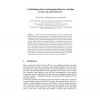Free Online Productivity Tools
i2Speak
i2Symbol
i2OCR
iTex2Img
iWeb2Print
iWeb2Shot
i2Type
iPdf2Split
iPdf2Merge
i2Bopomofo
i2Arabic
i2Style
i2Image
i2PDF
iLatex2Rtf
Sci2ools
ARTQOS
2003
Springer
2003
Springer
Calculating End-to-End Queuing Delay for Real-Time Services on an IP Network
A crucial factor for real-time (interactive) services is the end-to-end delay experienced by the application. The contribution resulting from the queuing delay induced by the network nodes is the most difficult to assess. First, it is a stochastic quantity which should be aggregated over many (possibly different) network nodes. Secondly, the queuing delay in a single node stems from two different mechanisms: one related to interference with other interactive flows and one related to interference with the ubiquitous best-effort data flows. Earlier work assessed these two components separately, leading to a ‘worst case’ result. This paper models both components and develops formulas to calculate exact results for the end-to-end queuing delay. Results are shown indicating an improvement up to 45% over the worst-case method. The formulae developed in this paper are expected to be useful in network dimensioning, in setting network performance requirements and in admission control mechan...
| Added | 06 Jul 2010 |
| Updated | 06 Jul 2010 |
| Type | Conference |
| Year | 2003 |
| Where | ARTQOS |
| Authors | Robert E. Kooij, Olav N. Østerbø, J. C. van der Wal |
Comments (0)

